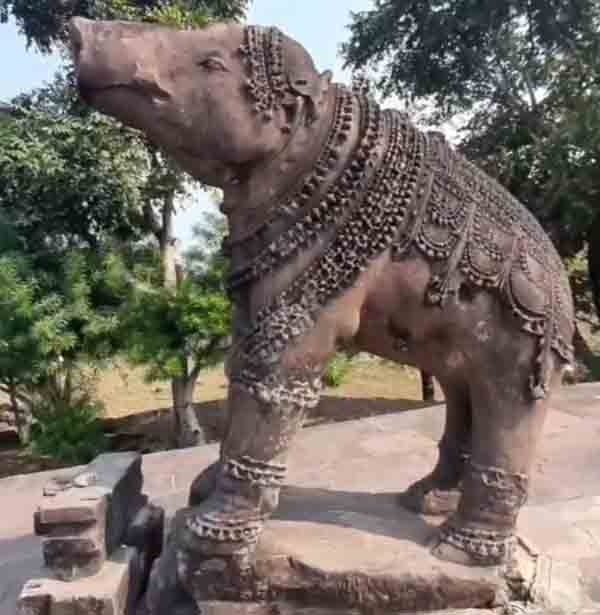The large red sandstone boulders of Kaimur Range have for long fascinated the rulers of Central India be it the Guptas, the Paramaras, the Chalukyas of Kalyani, Gurjara-Pratiharas, Gahadavalas and others to mention a few. Remarkable monolithic sculptures of red sandstone with exceptional detailing are found particularly in the Katni district of Madhya Pradesh.
Katni, for centuries has been known for its exquisite craftsmanship, art and architecture. Fragments of temples, forts, monasteries and structures from the Gupta period, the Kalachuris and successive dynasties are still seen in many villages in this district and surrounding districts.
The Kalachuris had made Bilhari and Karitalai into prominent art centres. It was during the reign of their greatest king Raja Lakshmikarna, also known as Raja Karna that Karanpur named after him became famous for its extensive temple complex that housed a stunning monolithic Vishnu Varaha, an impressive Shiva Linga, a kund, a fort and other structures.
The Vishnu Varaha is 8 feet long, 7 feet high and 3 feet wide. The intricate carvings on his back are nothing short of spectacular with great attention to detail paid to each and every feature of the adornment. It is important to remember that the tiny figures in yogic posture, the jewel and bead embellishments, figures mounted on the sides and the decorative elements on his feet and forehead have been made using only a chisel and hammer!
The most interesting aspect of this massive figure according to the locals is that it is the best and most accurate judge of character! It is said that if one tries to pass through the narrow gap between his hind legs, then he is deemed to be a good person else he is classified as a sinner!
There is a Shiva Linga right opposite Varaha that one must pray to while visiting this temple. A headless figure of probably either Mahavira or Gautama Buddha is also seen behind the Varaha.
Around this beautiful Varaha lies nothing but ruins – grand temples, halls, fort and other structures that once stood here reduced to rubble; the handy work of Muslim invaders starting from Shihabuddin Ghori also known as Muhummad Ghori or Muhammad of Ghor who ran amuck seeing the riches and wealth of the rulers of Central India.
The British who usurped power in 1818 also laid their greedy hands on several sculptures, ornaments and artefacts left behind by the Muslim invaders. It is surprising that they did not try to dismantle the statue of Varaha and take it back to their country for it to adorn one of their lordly estates built with the wealth of Akhanda Bharat.
The Archaeological Survey of India (ASI) has done an outstanding job of collecting the sculptures and remnants of the structures that once stood here. One can see the mastery of the artisans in each and every sculpture, carving and statue that lies around the Varaha.
Written by Lakshmi Subramanian
* Photos are only symbolic (Taken from public domain/internet and any copyright infringement is unintentional and regrettable)


Leave a comment